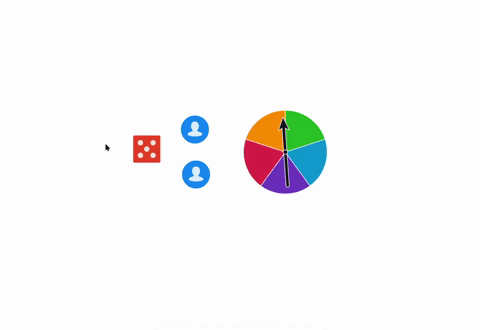What is Fair?
When playing a game or making a decision, we want it to be fair. Sometimes this leads individuals to flipping a coin or rolling dice. Are these really fair? Let's explore them to find out!
Before we begin, here is how to randomize a coin, dice, and spinner.

Coins
Now try it for yourself. Flip the coin below and use it to answer the questions.
A game is said to be fair if there are equal chances of winning and losing. That means probability of winning is the same as the probability of losing
Probability is the likelihood of an event happening. We can find simple probability using the following:
Let's experiment to find out if flipping a coin is fair. A coin has 2 outcomes, Heads and Stars (or Tails). To find out if flipping a coin is fair, flip the following 10 coins 5 times. Record the number of heads and tails for each set of flips in the provided table. (Double click the box to write the outcome)
Is this what you expected? You should have gotten close to the same number of heads as you did tails. It may not be exact though. This is due to something called Theoretical vs Experimental probability.
Flipping a coin is considered fair. Heads and Stars each have the same chances of showing up. There is a 50% chance of flipping a head or a star.
But you likely did not get 25 heads and 25 stars earlier. It may have been close but not exact. Why is that? In order to get a more exact prediction of if something is fair or to help determine the probability of an event, we need to do a simulation.
A simulation is the repetition of an event on a large scale generally using computers. Below we are going to run a simulation of flipping a coin. Using Polypad we can easily flip a coin 100 times.
Record the number of heads and stars in the table below.
Did you get close to 50 heads and 50 stars? If you were to flip 1000 coins you would be even closer! The more flips you do, the closer you get to 50% being heads and 50% being stars!
Spinners
Another type of activity that is used to simulate chance is spinners. If the spinner lands on the desired color you win!
Spin the following Spinners to complete the table below.
This spinner is not fair. Just by looking at it, you can see that the red area is much smaller than the orange and green areas. If you win when you spin red and your friend wins on the green, your friend would beat you most of the time.
Not everything is fair! Sometimes it is obvious, like the spinners above. Just by looking at it, you could see it is not fair. Sometimes it is not obvious and it takes running a simulation to determine if it is fair.
Dice
Let's use what we have looked at so far with dice! Below is a normal 6 sided die. Roll it a few times and answer the following questions.
A normal 6 sided die has 6 sides each with a number 1-6. Roll the following set of 10 dice 6 times and complete the table. Does the number of 1's rolled match your prediction from above?
When rolling a fair die, each side (or number) has a 1 out of 6 chance of being rolled. That means if you roll 60 dice, each number should come up close to 10 times.
Roll the following set of 12 dice 5 times. Using your knowledge of fair and unfair is this die fair?
Your friend has taken some unfair dice and mixed them in a bag with fair dice. Using your knowledge of fair and unfair can you sort the dice by fairness. Roll each die by itself to determine if it is fair or unfair and drag them to the correct side.
Note: Each die is 6 sided and you should expect the numbers 1-6.
Extension : Theoretical and Experimental Probability
Why does the simulation not always match the desired probability? When flipping a coin, you should get 50% heads and 50% stars. Why is it then that flipping 10 coins can result in 4 heads and 6 stars?
The reason for this is the difference between Theoretical Probability and Experimenmtal Probability
Theoretical Probability - The probability of an event happening based on reasoning.
Experimental Probability - The probability of an event happening based on an experiment or simulation.
These two types of probabilities may the same when an experiment or simulation is carried out over a large number of trials, but they may differ when examining a smaller number of trials.
Take for example flipping a coin.
The Theoretical Probability of flipping a coin and flipping heads is 0.5 (50%) because there are only 2 outcomes, heads and stars.
If you flip a coin 10 times and get 4 heads and 6 stars, the experimental probability of flipping heads is 4 out of 10 or 0.4 (40%).
If you flip a coin 100 times or 1000 times the probability of flipping a coin and landing on heads will get closer and closer to 50%.
Let's go back to an example from earlier of rolling dice. Try finding the Experimental Probability of rolling a 6 below. How does this differ from the Theoretical Probability?